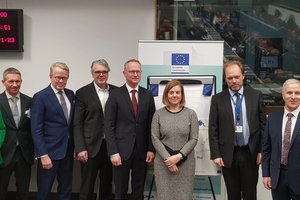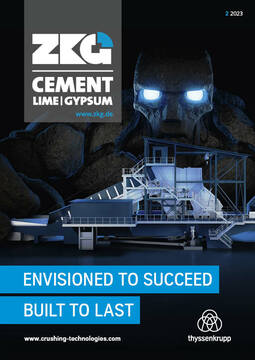EU invests over € 109 million in Holcim innovation project
A big step towards the revolution of the cement industry: The EU is investing € 109.8 million in Holcim’s innovative Carbon2Business project in Lägerdorf, Schleswig-Holstein. On 19 January, CEO of Holcim Germany Thorsten Hahn officially accepted the funding certificate in Brussels. The EU funding will be used to build a new kiln line. As an industrial-scale prototype for the decarbonisation of cement production, the oven uses second-generation oxyfuel technology as well as a downstream compression and cleaning unit for the CO2. The Carbon2Business project is one of two projects in Germany, and one of seventeen in total, that the EU is investing in using its € 1.8 billion innovation fund. Holcim itself is investing an amount in the triple-digit million range into the project.
“We are transforming our factory in Schleswig-Holstein into a pioneer of green cement production. It will be a technological flagship of international relevance,” said Thorsten Hahn, CEO of Holcim Germany, speaking during the Financing Innovation Clean Tech Conference at which the funding certificates were handed over. “The investment made by the EU is an important milestone and will enable us to drive the cement revolution with greater decisiveness.” In the scope of the EU’s selection process, independent experts evaluated factors such as the extent to which the projects seeking funding could sink greenhouse gas emissions in comparison to conventional technologies as well as generate ground-breaking innovation. Selection criteria also included the degree of maturity, scalability and cost effectiveness of the projects.
Method lowers annual CO2 emissions by 1.2 million t
Holcim is working with thyssenkrupp Industrial Solutions AG as a technological partner for the project, which involves using carbon dioxide from the Lägerdorf cement factory as a raw material for other industries.
“The success of the energy transition will also depend on the issue of the sustainable, i.e. CO2-neutral, production of building materials. Pure oxyfuel technology will be a key part of the solution and a key contributing factor to the success of the cement industry’s green transformation,” said Pablo Hofelich, CEO of the Polysius Business Unit at thyssenkrupp Industrial Solutions. With the oxyfuel method, pure oxygen is fed into the combustion process of the cement kiln instead of the ambient air. The oxygen required for this is taken from electrolysis projects where industry partners split water into hydrogen and oxygen using electricity from renewable energy sources. As a result, the oxyfuel method in cement kilns produces high-purity CO2 which can be collected and subsequently turned into methyl alcohol through methyl alcohol synthesis or used as a primary material in the chemicals industry, for instance in order to make plastic. For the processing of the CO2 collected, Holcim works closely with the specialists from Linde Engineering. At the Lägerdorf site alone, the method reduces annual CO2 emissions by 1.2 million t.
From greenhouse gas to raw material for industry
“Together with our partners, we are developing an efficient circular concept based on an innovative hydrogen economy on the west coast of Schleswig-Holstein and at our Lägerdorf site. It can serve as an example for the cement industry and other industries around the world to follow,” explained Arne Stecher, Head of Decarbonisation at Holcim Germany. “Innovative technology is enabling us to almost completely separate CO2 for the first time ever. This means it can be processed and finally reused in industry as a sustainable raw material.” In this way, Holcim and its partners are creating new value chains and developing technologies that are paving the way for the carbon neutralisation of industrial companies both in the cement industry and beyond.
With the handover of the funding certificate and the ceremony in Brussels, the Carbon2Business project is now officially underway. Holcim is planning to submit the plans for the construction of the oxyfuel kiln between the end of 2023 and 2024. The construction is expected to have been approved by the end of 2024. If all goes to plan, one of the first climate-neutral cement factories in the world will be able to start up operations by 2029.






